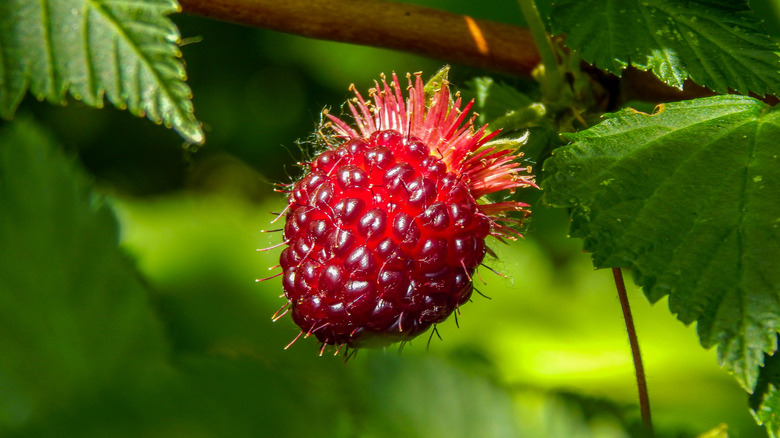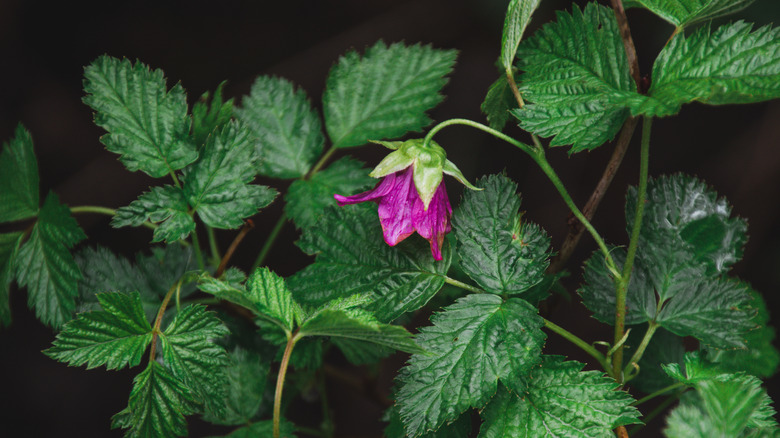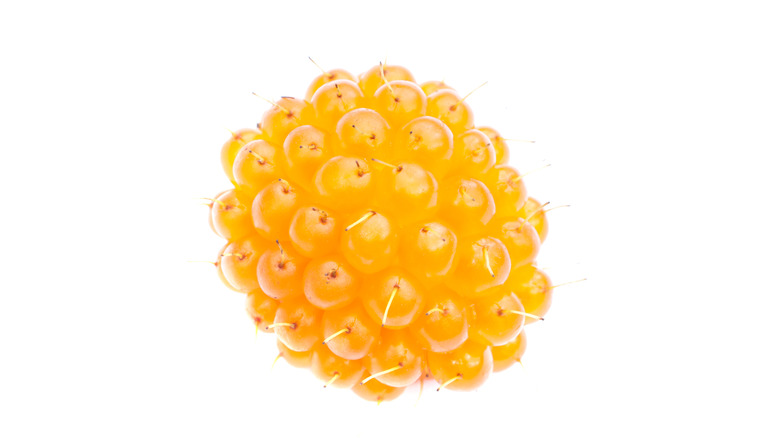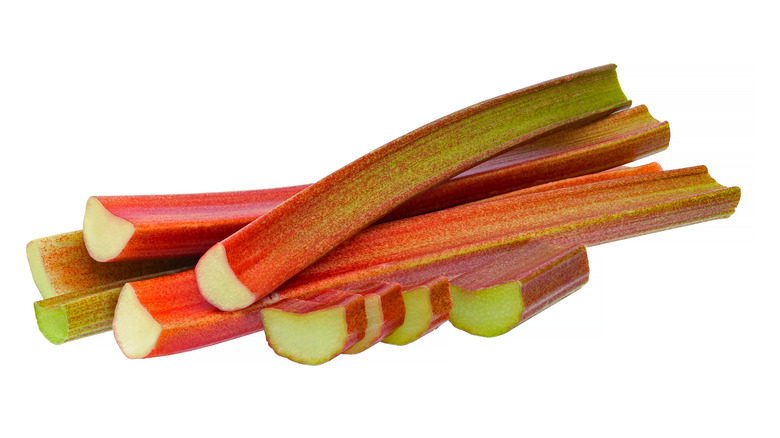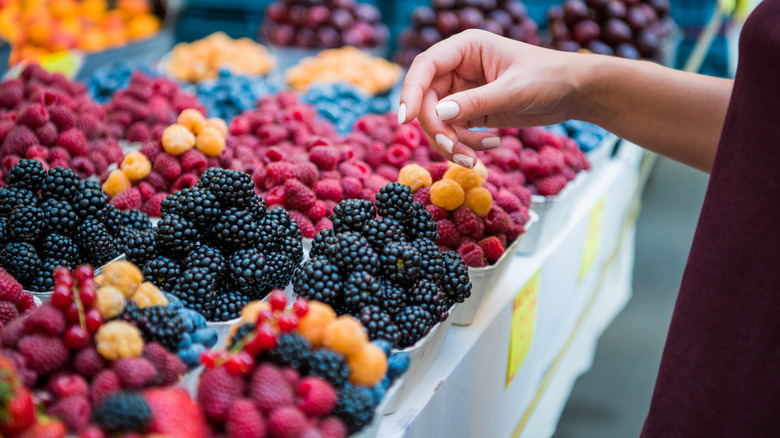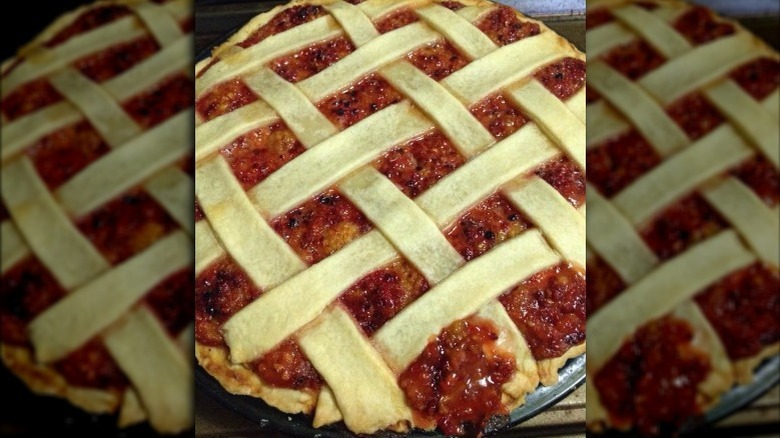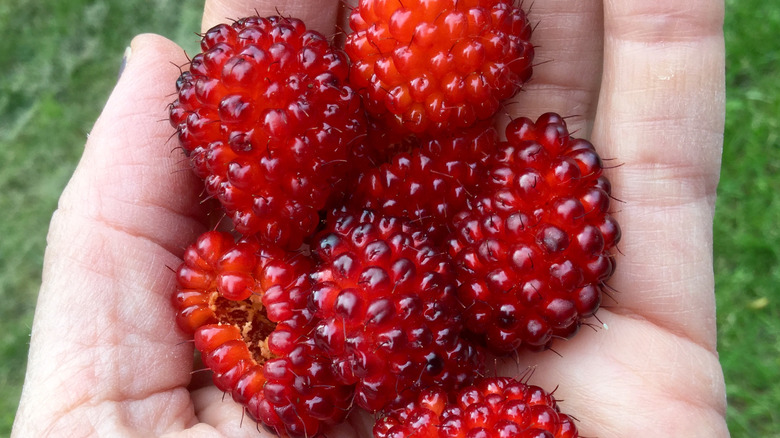What Is Salmonberry And What Does It Taste Like?
If you hear the word salmonberry, it might conjure images of the salmon's distinctive orange roe, popularly eaten in Russia and Japan.
Salmonberries, however, are not eggs. Though they can be similar in color to fish eggs, they are a fruit related to the raspberry, blackberry, boysenberry, cloudberry, dewberry, and loganberry (via Britannica). While not everyone in the U.S. and Canada can easily experience fresh salmonberries, in the spring and summer of the Pacific Northwest, British Columbia, or Alaska, you can grow them yourself, forage for them, or find them at farmers markets or grocery stores, per Oregon State University.
Though slightly tarter than their more popular cousins, salmonberries are delicious when preserved or baked into pies and cakes. What's more, like many berries, they are a good nutritional bargain: salmonberries are low in calories and rich in antioxidants. But before you cook with them, you should know how to pick out salmonberries and how to handle them.
What are salmonberries?
Rubus spectabilis, more commonly referred to as the salmonberry plant, (via Native Plants PNW) is a member of the Rosaceae (rose) family and the subfamily Rosoideae, according to Britannica. The genus gets its name from the Latin word for red, "ruber." Spectabilis ("spectacular") refers to the salmonberry shrub's eye-catching pink flowers and bright reddish fruit. Members of the Rubus genus, more commonly referred to as "brambles," include salmonberries as well as blackberries, raspberries, and boysenberries.
The salmonberry plant grows naturally along the northwestern coast of the Americas, from northern California to Southern Alaska. Although its primary habitat is the western slope of the Cascade Mountains, it also grows in parts of eastern British Columbia and northern Idaho, according to Native Plants.
Like its more famous relative the raspberry, the salmonberry fruit features a hollow core and clustered drupelets. The color of the berries ranges from yellow to orange-red, and they tend to grow larger than raspberries or blackberries.
How salmonberries got their name
In the Pacific Northwest, Alaska, and the Canadian coast, salmonberries were an important part of the indigenous people's diets. This, according to SF Gate, is because these berries were one of the earliest to ripen each spring. First Nations people ate them with dried meat, salmon, or with salmon eggs, according to Native Plants. This is one theory about how the fruit got its name.
Because they were too watery to dry, according to Native Plants, salmonberries were eaten only fresh, sometimes prepared in the grease of oolichan, a smelt-like fish. Other theories about how the salmonberry got its name include the pinkish-hue the berries sometimes have or their resemblance to salmon roe.
Indigenous peoples also made use of the young sprouts of the salmonberry plant, peeling them and eating them raw or steamed. Medicinally, the bark was used to treat burns, according to Native Plants.
What do salmonberries taste like?
The taste of raw salmonberries might disappoint those expecting something similar to raspberries or blackberries. Salmonberries are tart, with a hint of sweetness, according to Art of the Pie. However, the more mature the berry, the sweeter and more tender it will be. Native Foods Nursery describes them as subtler than other berries and well suited for compotes. You can use salmonberries wherever you'd use blackberries, raspberries, or blueberries, although your favorite recipe might require extra sugar.
Their flavor is said to be reminiscent of rhubarb, and like rhubarb, they are suitable for pies. Another difference between salmonberries and their better-known relatives including raspberries and blackberries is that salmonberries have a prolific number of large seeds, making them less appealing to eat or to use raw (via Homestead Dreamer). They're well suited to jams and jellies, however, where the seeds can be strained or softened by cooking.
Where to buy salmonberries
If you are curious about fresh salmonberries and live in the Pacific Northwest, British Columbia, or Alaska, you are in luck. You should be able to find salmonberries in your local grocery stores or farmer's markets in the spring and early summer. If you live outside this region, fresh salmonberries are nearly impossible to come by. Since the plants do not grow well outside USDA agricultural zones 5-9 (the California, Oregon, and Washington coasts), and because the berries are very perishable and do not hold up well to transportation, it's rare to find salmonberries in other regions of the United States, per Practical Self Reliance blog.
Salmonberries can be picked in the wild and are best eaten the day they are picked, according to Farm to School Alaska. Ripe salmonberries are often orange-to-red in color. Don't over-handle these fragile fruits, and don't wash them unless they are visibly dirty. Refrigerate them in a covered, shallow container so these delicate berries do not become crushed.
Preserved salmonberry products are easier to come by. Specialty retailers such as Alaska Feed Company sell Salmonberry jam. Tongass Trading Company offers salmonberry syrup and salmonberry jelly and honey, as well as other products made from this fruit.
How to cook with salmonberries
If you're lucky enough to come across fresh salmonberries, there are a number of ways you can use them. Strained salmonberry pulp and juice are incorporated into the batter over this cake posted by an AllRecipes user. After punching holes into the cake with a toothpick, a fresh salmonberry syrup is also drizzled over the top of the cake.
Salmonberries also make an excellent pie filling, just remember that you'll need more sugar than you would with another type of berry pie, as salmonberries can be very tart. This pie from Food Network adds cardamom for a spicy counterpoint to the fruit. A recipe for salmonberry jam strains some of the seeds with a cheesecloth or sieve and uses sugar and pectin (via AllRecipes). For a real show-stopper, try Port and Fin's recipe for miniature pavlovas topped with whipped cream, salmonberries, honey, and basil.
Nutritional information for salmonberries
According to Nutrition Value, salmonberries are very similar to raspberries in their nutrition profile. A 100-gram serving has 47 calories (raspberries are slightly more with 52). They're also similar in their sugar and carbohydrate content. Salmonberries have less fiber, however, with 1.9 grams, versus raspberries' 6.5 grams. Raspberries are the better choice as far as vitamin C, however, with 29% of your recommended daily value (RDV), versus salmonberries' 10%.
Interestingly, berry-producing plants that thrive under inhospitable conditions, such as the cold and wind of Alaska, might have more phytochemicals than the fruit of plants grown under gentler growing conditions. This is because the plants, in order to adapt and thrive, produce protective secondary phytochemicals. These chemicals not only help the plant to survive extreme weather but can also have health benefits to the animals, including humans, who go on to consume them (via Penn State University Kellogg Lab).
